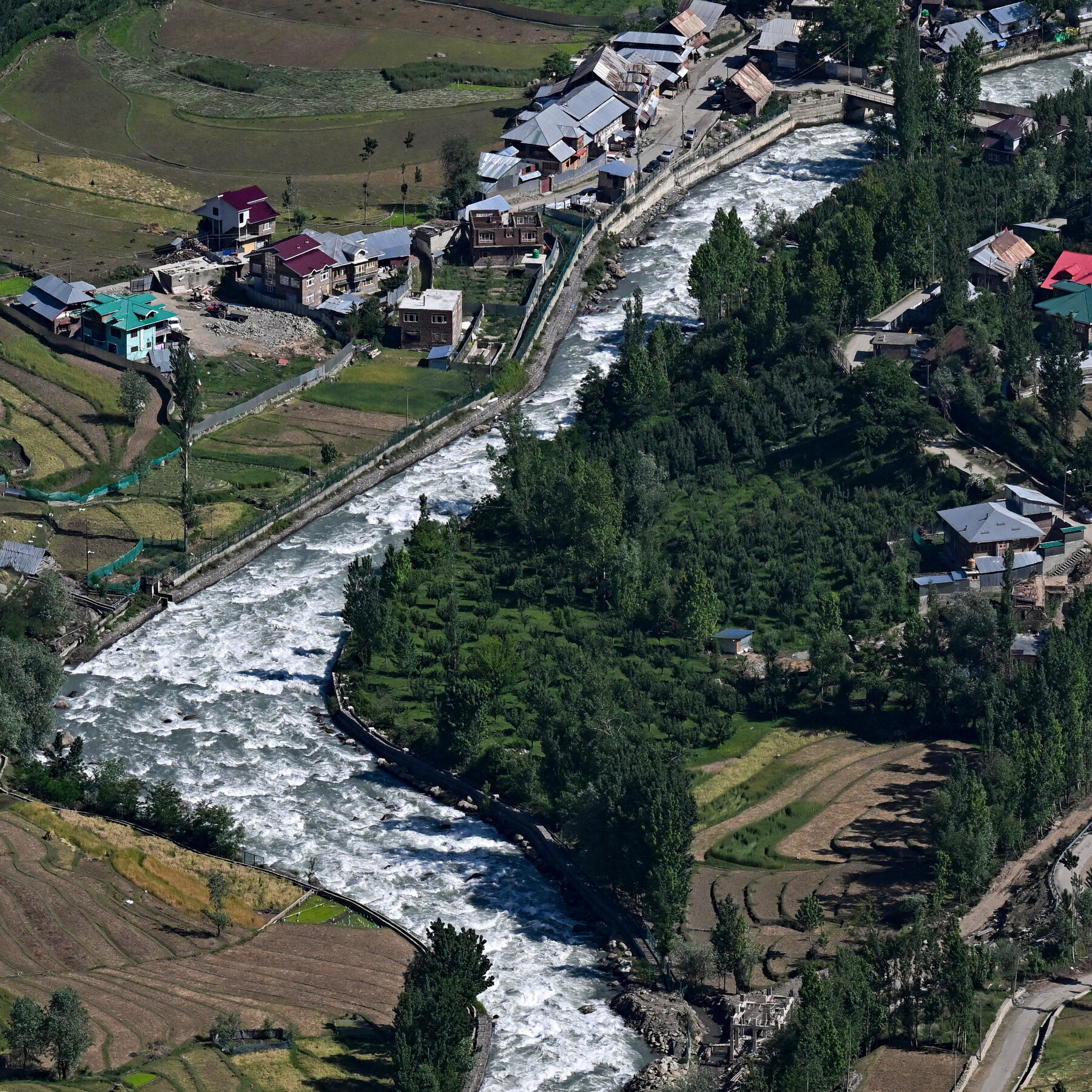Why Kashmiris Want the Indus Waters Treaty Suspended | Rising Public Demand Amid Climate Crisis
By: Javid Amin | Srinagar | 16 July 2025
A Valley at Boiling Point
In the heart of the Himalayas, Kashmir—a land known for its glacial rivers, pristine lakes, and rich agricultural tradition—is today grappling with a crisis it did not create but must now confront. Climate change, coupled with structural water-sharing imbalances codified in the 1960 Indus Waters Treaty (IWT), has ignited a groundswell of public anger and demand for justice.
In recent years, summers in Kashmir have grown hotter, rainfall patterns have turned erratic, and irrigation systems—once the pride of the valley—have gone dry. Power outages now plague both homes and industries despite the fact that J&K produces an abundance of hydroelectricity. Farmers, once the backbone of the local economy, are left counting losses. And amidst this backdrop, an old treaty—once hailed as a diplomatic success—is now being seen as an albatross around Kashmir’s neck.
After a deadly terror attack in Pahalgam on April 22, 2025, India announced its intention to suspend the Indus Waters Treaty. While this move reverberated across geopolitical circles in New Delhi and Islamabad, it struck a particularly resonant chord in the Kashmir Valley, where ordinary citizens and local leaders alike had long viewed the treaty as a historic injustice.
This article explores the roots of this growing resentment, weaving together voices from the ground, climate data, political developments, and legal arguments to examine why Kashmir is demanding a re-examination—if not a complete suspension—of the Indus Waters Treaty.
What Is the Indus Waters Treaty?
Signed in 1960 between India and Pakistan under the World Bank’s mediation, the Indus Waters Treaty (IWT) was designed to manage the distribution of water from the six rivers of the Indus basin. These are:
-
Western Rivers (allocated to Pakistan): Indus, Jhelum, Chenab
-
Eastern Rivers (allocated to India): Ravi, Beas, Sutlej
India agreed to allow Pakistan “unrestricted use” of the western rivers—80% of the basin’s total water volume—even though all six rivers originate in India or Indian-administered Kashmir. In return, India retained control over the eastern rivers.
Treaty Clauses & Kashmir’s Role
Kashmir’s geography makes it the source of three major rivers—Jhelum, Chenab, and Indus itself—yet its citizens are barred from utilizing the full potential of these water bodies. The treaty restricts India from building storage dams or diverting water from the western rivers, except under strict limitations.
Local critics argue that the treaty was negotiated without Kashmir’s consultation, treating the region as a mere conduit of water, not a stakeholder in its usage.
As Tanveer Hussain, a former top bureaucrat from the UT, put it:
“It is the people of Kashmir who see the rivers flowing past them while their taps run dry.”
The Climate Crisis is Local Now
The effects of global warming have become acutely visible in Kashmir:
-
Shrinking snowfall: The Chillai-Kalam winter phase, once marked by heavy snow, has shown a declining trend. Gulmarg—Asia’s largest ski resort—recorded barely any snow last year.
-
Deficit rainfall: Between October 2024 and February 2025, Kashmir witnessed a 74% deficit in seasonal rainfall. The result? Failed mustard crops, dried saffron fields, and a drinking water crisis in farming villages like Watlab and Sopore.
-
Melting glaciers: With snowmelt peaking earlier due to rising temperatures, irrigation schedules have collapsed. Farmers can no longer rely on the traditional rhythm of snow-fed irrigation.
According to Farhat Amin, an agronomist at Sher-e-Kashmir University of Agricultural Sciences:
“Kashmir is no longer just facing unpredictable weather. It is witnessing agricultural collapse in slow motion.”
Power Cuts in the Power House
Despite housing the Chenab Valley hydropower belt, Kashmir is a net buyer of electricity. Only 13% of power generated within Jammu & Kashmir is used locally, while the rest is sold to the national grid. Projects like Uri-I, Uri-II, Salal, Dul Hasti, and Baglihar continue to supply power to other Indian states while Kashmiris endure 8–10 hour load shedding during peak summer.
Farooq Dar, a hotelier in Srinagar, recalls:
“My father warned in the ’90s that we would suffer blackouts while others lit their homes with our water.”
This contradiction—of water wealth amid water poverty—has further galvanized the narrative that Kashmir has paid the price of India’s diplomacy with Pakistan.
Voices of the Valley — Ground Realities & Personal Struggles
At Sangri Top Watlab, a scenic village perched against the Pir Panjal range, 52-year-old Riyaz Ahmed Bhatt is preparing his rice fields for a third consecutive year of uncertainty. Last spring, a sudden overflow from a British-era canal submerged his mustard crop. The following summer brought a blistering heat wave, leaving his paddy scorched and yields halved.
Now, in 2025, Bhatt stands amid parched land and murmuring mountain winds with a desperate hope: that the water will return.
“There is no water, no rain, and our irrigation lines are dry. Every year, we pray to the sky. But nothing comes.”
His story is echoed across the valley.
In Sopore, farmer Sajid Mir recalls how the district administration had to supply drinking water through tankers last summer. For the first time in living memory, villages had no access to clean drinking water during the planting season.
“How can we grow rice or apples with tankers?” he asked. “Even our cattle had to drink once a day instead of twice.”
Mir’s apple orchards yielded only a third of the expected output due to rainfall deficits and lack of proper irrigation. Horticulture—accounting for over 40% of Kashmir’s agricultural economy—has been particularly hit.
Even saffron, the world’s most expensive spice, has withered on neglected fields near Pampore, as 60% of irrigation systems launched in 2010 under a central scheme have fallen into disrepair.
These stories are not isolated. They form a chorus of discontent reverberating across the region—one that links their suffering directly to decades of water mismanagement under the Indus Waters Treaty.
Political Storm — Omar Abdullah, BJP & the Treaty Debate
When Prime Minister Modi’s government formally announced its intention to suspend the Indus Waters Treaty in April 2025, it was received with support in Kashmir but also sparked deep introspection.
Omar Abdullah: “The Most Unfair Document Imposed on the People”
Jammu & Kashmir Chief Minister Omar Abdullah called the treaty:
“The most unfair document ever imposed on the people of this region.”
His remarks came just days after a terror attack in Pahalgam reignited debates over Pakistan’s role in Kashmir. But Omar’s statement went beyond security—it reflected a long-held belief in Kashmir’s political circles that the region was never consulted when the treaty was signed.
Omar’s government has since launched a study into water loss and power imbalance caused by the IWT. The study aims to quantify how much Kashmir has sacrificed since 1960.
BJP’s Shifting Stance: Strategic Move or Regional Bias?
Interestingly, the BJP’s local units in Jammu have shown lukewarm support for the suspension, fearing that increased use of water upstream might reduce flow in Dogri-speaking districts downstream.
Nationally, however, BJP leaders have championed the suspension as part of a broader assertive water diplomacy strategy aimed at punishing Pakistan.
This divergence highlights the internal contradictions within Indian federalism: Kashmir’s cry for fair use of water clashes with both international treaty constraints and intra-national politics.
Legal & Strategic Implications of Treaty Suspension
Suspending or terminating an international treaty is never a simple task. While India has cited Article 62 of the Vienna Convention (which allows for termination due to “fundamental change in circumstances”), the legal road ahead remains fraught with challenges.
What Happens if India Fully Exits the Treaty?
-
Pakistan could approach the International Court of Justice or World Bank, arguing that India is violating a binding agreement.
-
India would gain complete control over all six rivers—but would need to make massive infrastructure investments to fully utilize western rivers.
-
Kashmir may finally be allowed to use stored water, build dams, or receive priority power from its own projects.
Water experts like Professor R.K. Sharma from Punjab Engineering College warn:
“India cannot just walk away. It needs to build strong scientific and diplomatic frameworks before cutting off water. Otherwise, downstream consequences could be disastrous—both diplomatically and ecologically.”
But in Kashmir, many say the cost of inaction is already disastrous.
A Call for Rewriting the Future — What Kashmir Wants Now
More than just water or electricity, Kashmiris are demanding justice—for past neglect, present hardship, and a better future.
Key Demands from the Region:
-
Renegotiation of the Indus Waters Treaty with local stakeholder consultation.
-
Greater local share of hydropower generated in J&K, especially during summer and winter peak loads.
-
Restoration and modernization of irrigation networks, particularly in saffron, paddy, and apple belts.
-
Glacier monitoring programs and investment in water-efficient farming technologies.
-
Legal recognition of Kashmir’s water rights in national policymaking.
Ambreen Shaikh, a teacher in Srinagar, puts it best:
“The Indus Treaty may be a line on paper between India and Pakistan, but its true boundary lies across our farms, taps, and schools.”



